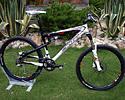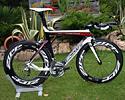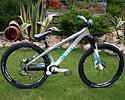
Recently on Cyclingnews.com |
Tech feature: Scott 2009 introduction, June 19, 2008
Scott bolsters its off-road line-up for 2009
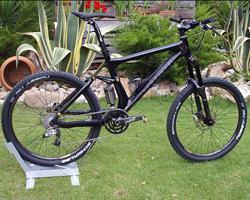
|
Scott has been on the cutting edge of road bike development for years and is now paying a little extra attention to the off-road crowd. Guy Kesteven heads to Spain to check out the complete 2009 range.
A work of Genius?
Scott's initial line of Genius trail bikes had all the makings of a winner but a patent infringement issue with Specialized unfortunately meant that US buyers weren't able to partake in the fun. Scott has now taken care of the problem with a newly redesigned Genius and while the new iteration is more evolution that revolution, there's certainly some very smart thinking in there.
This latest Genius isn't just about getting around legalities, though, as it's both lighter and longer travel than before. The top LTD model now weighs just 10kg (22lb) yet packs 150mm travel front and rear. Yup, that's right - six inches of travel in a package lighter than most full-blown race bikes.

|
Making that possible is a totally new 2250g (4.96lb) chassis (1840g frame/410g shock, claimed)) built using a new IMP4 (Integrated Moulding Process) carbon construction technique. The monocoque front triangle skips the usual inflatable internal bladder in favour of solid mandrels similar to what it already uses on its Addict road frame. How Scott removes those mandrels remains a mystery but this carbon fibre equivalent of 'ship in a bottle' modelling supposedly yields far more precisely-controlled tube wall dimensions than usual monocoques that result in a lighter, stiffer and stronger finished product..
Alloy bits are used for the bonded-in bottom bracket/lower pivot block, headset and disc mount, as well as the skeletal triangular rocker links. In typical Scott fashion, everything else - including the dropouts - is all carbon fibre.
Despite the layout remaining visually very similar this new model bears some significant changes. Firstly, last year's Horst link chain stay pivots have moved to the seat stays to side step US patents and turn the rear from true four bar to low pivot swingarm 'faux' bar. 'Gusset' style reinforcing bulges sit under head tube throat and seat tube armpit of the frame and the seat tube flares out massively where it bottoms onto the down tube. In fact there's a lot of profiling all over the place and the result is a frame that's no iron bar, but certainly a lot stiffer than we expected and well within acceptable limits for its superlight category.
This is all the more impressive because, as usual, the included DT Swiss is fitted with spherical eyelet hardware that isolates it from potentially damaging frame loads but lends no additional rigidity to the back end. The updated Equalizer 2 triple chamber design still looks like a small chemical plant tucked in between mainframe and back wheel but there's a good reason for the industrial appearance.
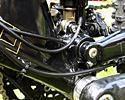
|
As with the first generation Equalizer shock, oil flow - and therefore air spring compression - between the three chambers is controlled by a remote 'Tracloc' lever on the handlebars. In 'fully open' mode all three chambers are used to give 150mm of travel. 'Traction Control' shuts one chamber, limiting travel to a much more progressive 95mm, and 'Lockout' closes the valves to both sub chambers for a completely solid shock mode with a preset blow-off valve for protection when (not if) you hit a descent without remembering to let it loose. The new metal double push remote lever (think inverted SRAM trigger) is well placed just under your thumb and toggling between modes soon becomes second nature as terrain varies.
The new - and presumably far more durable - chunky alloy lever is also just one of the signs that Scott is still keeping a keen eye on practical detail regardless of their obvious obsession with weight removal. The cable routing is completely sealed from front to back to minimise contamination and all frame sizes except the Small (which takes a medium 500ml bidon) has room for a large water bottle in the main triangle. The rocker links even pivot separately on either side of the seat tube on stub axles so you've got full, interruption free seatpost height adjustment. Tyre clearances are good too, with a 75mm-wide chain stay spacing giving ample room for a true 2.35in tyre.
Cleared for take off
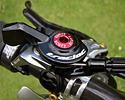
|
Can you really create a bike that is both superlight and yet confident enough to need big tyre and seat drop capability? The absolutely bang-on layout and angles certainly help: the short stock stem lengths (around 70mm or so) makes for snap reactive steering feel but there's still ample top tube length for decent breathing space. It's not race bike long but it's certainly no knee knocking lung constrictor when you're trying to grind you're way up another 30 minute loose gravel Spanish climb, either.
What really works well is the effect the various shock settings have on geometry. With the rear shock locked the angles are relatively steep to keep the front wheel anchored on steep climbs; slapping the crown-mounted Launch Control lever on the fork makes it steeper still for proper stalling speed crawler slabs. Things slacken out to around 68.5 degrees in Traction Mode for comfortably confident stability while the fully open setting really allows the bike to settle back onto its haunches. Add a dropped seat and you've got a great position for even the most extreme gutter and mogul descents the Giverola guides took us down.
With tyre pressures dropped we were surfing either end of the bike relatively recklessly on the loose dry grit and sand of our Spanish test grounds. A quick straw poll confirmed all the other hacks were pretty happy with the position, too, which is a damn rare thing these days.
Mental instability
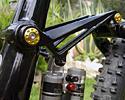
|
The actual trail connection and confidence takes a while to gain, though, purely because the bike is so light it rings all the wrong delicate anorexic alarm bells. You have to really concentrate to squat it down onto the trail for traction but as long as you keep low and keep believing it actually takes big hits and gulley gouged mogul fields really well. Dial in the dual rebound and there's no obvious kick-up from the big stuff and it's tight enough to really rail off camber stuff as hard as the Schwalbe rubber will let you. In fact we were surprised how much confidence we were placing in the bike and how fast and loose we were letting it run even after only two (admittedly long and full-on) days spent riding it.
Despite the change to faux bar there's no obvious pedal tug over rippled/rocky trails, either, and braking seemed pretty good despite the naturally treacherous surface. You will notice bob if you toggle between the shock modes at low revs, but again it's hard to say how much of that is because of the instant contrast you don't get on other bikes. It's certainly not enough of a wallow to undermine the exceptional climbing prowess gifted by its weight, and if first to the top means anything to you, this bike has to be on your wish list.
Canning the can

|
As for the Equalizer shock action it's controlled rather than über plush. The outrageously high shock pressures and 3:1 leverage ratio mean there was no trail sucking effect to be had even when running the cans way lower than Scott recommends. In fact we soon gave up wallowing around and went back to around 90 percent of suggested pressures and were a lot happier. It's definitely closer in feel to 120-130mm bikes than a full 150mm but again some of that is due to the lack of weight forcing the shock to work hard. Then again there was none of the 'running in high heels' or 'wallowing in a travel no man's land' sensations that are all too common on long legged XC bikes.
The bottom line is that this bike is a lot more trail-capable and confident than we were expecting from a bike this light. How much extra speed and control that extra 20mm of travel the Genius offers over most of its competitors is a longer term test question. What we will say though is that the base shape of the bike and its geometry are excellent and DT's involvement should be a big help in terms of shock reliability and consistency.
How much?
As one would guess, all of this technology, performance and lightweight come
at a severe price. Projected to be well over the US$11,000 mark, the Genius
LTD will easily be one of the most expensive off-the-peg bikes around although
it does also include some ultra-premium componentry including the latest carbon
chassis 150mm fork with 15mm quick-release thru-axle and carbon rimmed wheels
from DT Swiss plus Formula's stunning new R1 ultralight brakes.
Those not about to jump in a van with Patrick Swayze and a collection of US
president masks can also take solace that the cheaper bikes are belters, too.
The heavier Genius 20 with Fox 150mm fork and XT trim on the same frame actually
felt noticeably smoother and more confident on fast, technical trail sections
than the LTD. Likewise, the significantly cheaper alloy versions look really
good, too, complete with custom RockShox Revelation 150mm forks.
Photography
For a thumbnail gallery of these images, click here
Images by Guy Kesteven
- The new 2009 Scott Genius LTD offers true trail bike capabilities mixed with race bike-like weight.
- Pivots have moved from the chain stays to the seat stays in order to get around patent issues in the US market.
- In essence, the Genius is now a low single-pivot design in contrast to last year's true four-bar linkage system.
- The new Equalizer 2 rear shock uses multiple chambers that can be selectively opened and closed to adjust the rear travel.
- The handlebar-mounted remote has been upgraded to aluminium construction that's heavier but far more durable than the previous plastic one.
- The skeletal-looking rocker arms mount to stub axles on the seat tube to allow for full seatpost height adjustment.
- The top-end Genius LTD commands an astronomical price tag but comes with ultra-high zoot parts to match.
- The Genius LTD's included DT Swiss XRC330 alone cost more than most people's complete bikes.
- Budget-minded riders also have the option of an alloy Genius that offers suspension and handling characteristics similar to the top-end LTD model but with a far more reasonable price tag.
- Heavily shaped tubing makes the Genius frames feel stiffer than their weights would suggest.
- The Scale carbon hardtails are mostly unchanged for 2009 with the exception of a bare unidirectional carbon top sheet to shed a few grams.
- 2009 Scales will come with Schwalbe's new Rocket Ron treads.
- Scott will introduce a new alloy version of its short-travel Spark for 2009.
- Cyclo-crossers can lighten up this fall with a new all-carbon frame said to weigh less than 1kg.
- Like it or not, the integrated mast helps shave a handful of grams to help Scott achieve the claimed sub-1kg figure.
- The wishbone-style rear stays include a cleanly integrated rear brake housing stop.
- Scott also showed off its newly redesigned Plasma which it officially introduced during this year's Giro d'Italia.
- The unique rear stay arrangement helps smooth airflow over the rear brake.
- The Plasma head tube is especially narrow and the fork is well integrated with the frame.
- The massive bottom bracket section supposedly helps redirect air around the churning rear wheel.
- Radically shaped 'Twin Turbo' chain stays include internally routed derailleur housings.
- The revamped Voltage dirt jumper sports super short chain stays for manuals that you have to but think about to pull off.
- Ultra-burly seat stays flow right into the top tube.
- Those aren't gussets welded to the head tube; they're directly built-in for more strength than separate bits.

